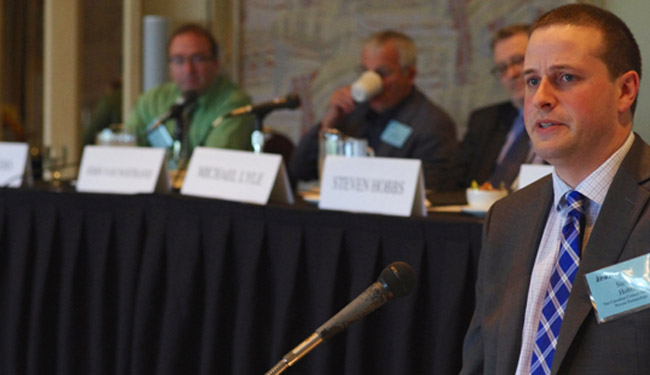Infrastructure needs in Northern Ontario addressed at Ontario Mining Forum

By Rick Garrick
THUNDER BAY – Public-Private Partnerships (P3s) were presented as one option to meet infrastructure needs across northern Ontario during the 5th Annual Ontario Mining Forum.
“(P3s are) not the magic bullet solution, but I think it is one option that can build some of the key critical infrastructure, both (for) major mining projects but also in the communities that are surrounding these projects,” says Steven Hobbs, director, Strategic Planning and Partnerships with The Canadian Council for Public-Private Partnerships. “A P3 is a partnership between the public sector and the private sector to procure public infrastructure and services. The private sector designs, builds, finances, maintains and sometimes operates public infrastructure under one procurement process. P3 projects are always owned by a government, whether that is the federal government, provincial government, municipal government or First Nations government.”
Hobbs says P3s transfer risk of cost overruns and project delays from the government to the private sector because the private sector is financing the project and does not get paid until the project is completed.
“That tends to be a very motivating factor to the private sector, who is not going to make a profit on the project unless they actually delivered it on time and on budget and to the specifications that the government has set out,” Hobbs says. “(The government pays) a small premium to ensure that if anything goes wrong on a project during its life cycle, that burden is now shifted to the private sector.”
Hobbs says two P3 projects have been developed to date in First Nations across Canada, a correctional centre on leased Osoyoos Indian Band territory and a hydro-electric project by Namgis First Nation and Brookfield Renewable on Vancouver Island.
“Our organization believes there is the opportunity for a lot more use of the P3 model in First Nation communities, but there are currently some barriers that exist,” Hobbs says, noting that funding agreements are one issue. “Communities often get one, two, if they are lucky, five-year funding agreements (while with) P3 projects, the contracts tend to be 25-35 years. So how is the community going to leverage against future revenue if they only have guaranteed funding for a couple of years.”
Hobbs says First Nations could benefit from the bundling of infrastructure projects into $50-100 million P3s, noting that First Nation communities have the largest infrastructure deficit in Canada.
“We tend to find that the best projects are the ones that are larger scale — $50, $75, $100 million or more — which is why bundling becomes a huge incentive,” Hobbs says. “In Nova Scotia, they are looking at bundling a number of water and wastewater facilities. You could do the same in northern Ontario.”
Keynote speakers at the Ontario Mining Forum were Christine Kaszycki, assistant deputy minister for the Ring of Fire Secretariat, Nishnawbe Aski Nation Grand Chief Harvey Yesno and Mushkegowuk Council Grand Chief Lawrence Martin.
Panel discussions included Facilitating the Orderly Development of the Ring of Fire’s Massive Potential; Building Consensus for Mining and Transportation Infrastructure Development; Reporting under the New Extractive Sector Transparency Measures Act (Canada); Building Trust, Managing Risks, Unlocking Value; Ensuring Smart Environmental and Regulatory Safeguards in Order to Uncover the Economic Potential of Northern Ontario; Aligning Infrastructure Projects with the Vision of the Growth Plan for Northern Ontario; and Proposal for the Construction and Operation of the Ring of Fire Railway.


